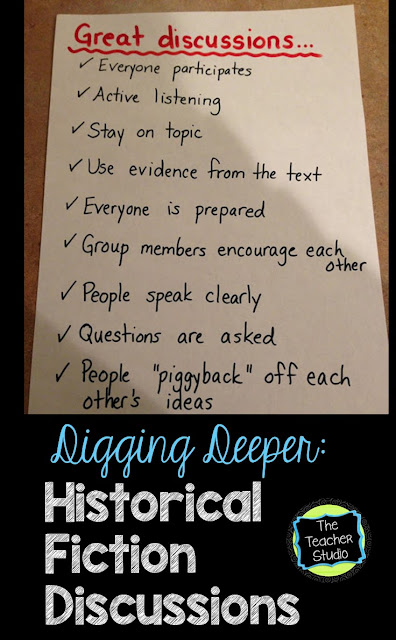I thought I would update today with a little update on our historical fiction book clubs! If you remember, the other day I posted about needing a little “911” for our discussions (Click HERE to read that post). . . well, let me tell you–it WORKED!
Here’s what I did . . .
We started off class on Friday by reviewing the anchor charts we had made the other day (the models for what we wanted discussions to look like and the what to do if you are “stuck” in discussions), and the students remembered exactly what we had talked about. Then, thanks to my dear friend and coworker across the hall, I pulled up a great video link of a fourth grade historical fiction book group! We watched it as “critics” and kept track of all the things we thought that group did well. I was so impressed with what my students noticed! Together we built an anchor chart listing them all…
I was pretty impressed with what they noticed! We all agreed that we needed to “step up” the discussions from their first meeting. . . we self-evaluate our groups after each one. Most students gave their groups 2’s or 3’s last time, so we knew we had room to grow!
Like last time, I posted a few discussion prompts on the Smartboard, asked them to look over their written “Pausing Points”, and to bring their texts with them to group. Today’s discussion points?
–Have you learned more about your main character? Explain.
–What clues has the author given you as to the setting/era of your text? Go back into the text to show your group what the author has done.
–What are the key events that have happened so far? Why do you think they are important?
I then called the first two groups (I get two groups going in opposite corners of the room), and then I sat and listened. I make it a point of NOT being in the circle. . . I want the students to run the discussion and not look to me for guidance. I simply take some notes, listen, and flit back and forth between the two groups. Let me tell you–THEY LISTENED AND LEARNED! I was so excited! The discussions had so much more energy, so much more life–one group talked for 30 minutes! You could feel that the tides had turned and that they felt so much more confident in what they were doing. When we evaluated after this group–every group gave themselves 4’s! Now–don’t get me wrong–we have not reached perfection! Some students are still struggling to participate equally, some students still are reporting out at a more literal level, and so on. That being said, the bar has been raised and they know it!
Help for teaching historical fiction
I was so motivated that I went home and finished writing up the unit . . . I don’t know who else might be interested, but I know that some of the resources would be really helpful for anyone teaching historical fiction! Seriously–I am doing my book groups where the students are all reading self-selected books, but you could do them with leveled books, book clubs with books on a theme, or even the whole class reading the same book but then breaking into small groups for discussions. I am LOVING the pausing points I am using. . . students are writing and proving their ideas with details from the text, they are thinking more deeply, and they are coming to discussion groups prepared! I plan on using some more of the “pausing points” with some of the picture books we will be reading this week. Check it out if you are interested!






